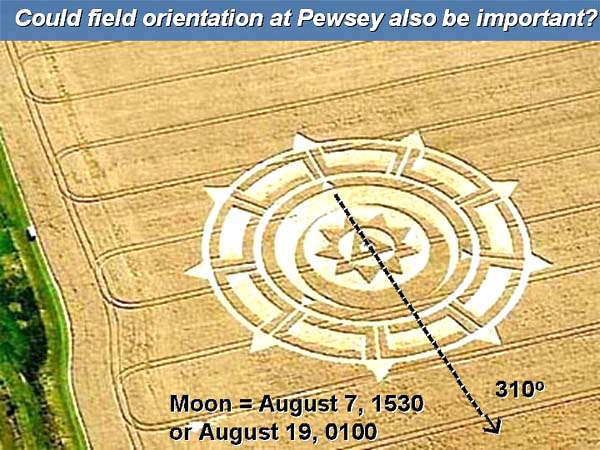|
Several crop pictures from the summer of 2007 have suggested a
near-future date of August 18 for the occurrence of some unexpected
event, that may cause Earth's scientists to take the crop-circle
phenomenon seriously.
On
July 7 at East Field, a series of lunar phase cycles seemed to end
anomalously on August 18, just six days after a new Moon. Then on
August 1 at Sugar Hill, a series of cube sundials were used to
symbolize a time interval of only 18 days, between midnight on July
31 (when that crop picture appeared) and midnight on August 18.
Now on
August 4 at Pewsey, we have been presented with a "solar-lunar
calendar" that gives precise dates based on motions of the Sun
and/or Moon. We need to study it carefully in order to understand
what they are telling us:
Lunar phase information
With
those ideas in mind, I first calculated a precise value of "lunar
phase" as shown in that new crop picture, based on the geometry of
its large internal crescent which seems to symbolize the Moon.
Most
astronomers define lunar phase in terms of "fractional
illumination", or how much of the Moon's surface facing Earth is
illuminated by sunlight. We can find fractional illumination from
the Pewsey crop picture by measuring the area of a large outer
circle (surrounding that crescent), minus the area of a small inner
circle (internal to the crescent), then dividing by the area of the
large outer circle.
From
published photographs, I measured diameter (outer circle) = 123 mm
versus diameter (inner circle) = 100 mm. Those values give radius
(outer circle) = 61.5 mm versus radius (inner circle) = 50.0 mm.
Taking the squares, we find (3782 - 2500) / 3782 = 34% lunar phase.
Another photograph gave 32%. Perhaps someone might wish to measure
in the field?
Using
a program from the web (http://aa.usno.navy.mil/data/docs/AltAz.html),
one can determine that a narrow
range of lunar phases from 32-34% gives near-future times based on
GMT as either August 7 from 0700 to 1200, or else August 18 at 2400
to August 19 at 0600. In light of other recent crop pictures, the
latter might seem more relevant than the former:
Solar azimuth information
Next I
tried to find out what they were telling us concerning the Sun? As
shown the in first diagram above, their solar calendar shows
threefold symmetry about the centre. Hence sunrise would lie on the
eastern horizon at 60 degrees, noon would lie high in the southern
sky at 180 degrees, while sunset would lie on the western horizon at
300 degrees. Another crop picture from Avebury last week likewise
showed threefold solar symmetry, on a date of July 31 for latitude
51 degrees North.
But
such symmetry depends on latitude, and may be calculated as August 4
(when Pewsey appeared) for latitude 52 degrees, August 7
for latitude 54 degrees, or August 18 for latitude 61 degrees. That
final value would correspond to southern Norway, where the ancient
inhabitants of Britain (called Tuatha de' Danaan) lived before they
migrated to Scotland, Ireland and Avebury. Further crop pictures
over the next two weeks will be eagerly anticipated. What
next?
An alternative interpretation that gives almost the same times and
dates for 32-34% lunar phase. But I remain unsure whether they
intended Pewsey to be field oriented or not.

Why was the lunar crescent at Pewsey oriented
toward a setting Sun?
Pewsey of August 4 showed a lunar crescent with 34% phase, that
could be interpreted either as a waning moon on August 7, or as a
growing moon on August 18-19. To resolve that ambiguity, the crop
artists oriented it in the field toward a setting Sun. Their
culturally-specific symbols often show "a new Moon coming out of the
setting Sun" (as at Stonehenge 1996), but never "a full Moon coming
out of the rising Sun".
Hence that lunar crescent at Pewsey seemingly refers to the "next
new Moon" beginning on August 13, which will reach 32-34% phase
after six days. Indeed, that was precisely what they showed at East
Field on July 7 for lunar cycle IV.
Red Collie
|